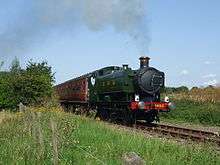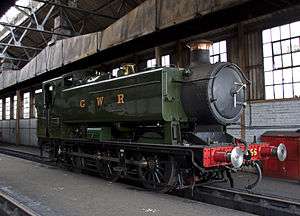GWR 9400 Class
|
9466 is one of two preserved members of the 210-strong class. Its Great Western Railway livery is inauthentic as it was one of those built for British Railways after nationalisation. | |||||||||||||||||||||||||||||||||||||||||||
| |||||||||||||||||||||||||||||||||||||||||||
| |||||||||||||||||||||||||||||||||||||||||||
| |||||||||||||||||||||||||||||||||||||||||||
| |||||||||||||||||||||||||||||||||||||||||||
The Great Western Railway (GWR) 9400 Class is a class of 0-6-0 pannier tank steam locomotive, used for shunting and banking duties.
The first ten 9400s were the last steam engines built by the GWR. After nationalisation in 1948, another 200 were built by private contractors for British Railways (BR). Most had very short working lives as the duties for which they were designed disappeared through changes in working practices or were taken over by diesel locomotives. Two locomotives survived into preservation, one as part of the National Collection.
Design

The 9400 class was the final development in a long lineage of tank locomotives that can be directly traced to the 645 Class of 1872. Over the decades details altered, the most significant being the adoption of Belpaire fireboxes necessitating pannier tanks.
The 9400 resembled a pannier tank version of the 2251 class, and indeed shared the same boiler and cylinders as the 2251, but was in fact a taper-boilered development of the 8750 subgroup of the 5700 class. The advantage was a useful increase in boiler power, but there was a significant weight penalty that restricted route availability. The 10 GWR-built locomotives had superheaters but the remainder did not.
The first ten 9400s were built by the Great Western and were the last steam engines built by the company. After the nationalisation of Britain's railways in 1948, private contractors built another 200 for British Railways.
The 9400s were numbered 9400–9499, 8400–8499 and 3400–3409. BR gave them the power classification 4F.
Duties

The 9400 class were used on Paddington empty stock work right up to the end of steam on the Western Region of British Railways. A familiar sight at the buffer stops at departure side in 1964–1965 was a filthy 9400 class locomotive devoid of number plates simmering at the head of a rake of British Railways Mark 1 coaches.
Numbers 8400 to 8406 served as bank engines on the Lickey Incline after its transferral to the Western Region.
In retrospect they were a wasteful investment, many having very short lives of less than 10 years as their intended work dried up and diesels took over their remaining duties. 8447 holds the unenviable record of the shortest life of any GWR loco in BR times, beginning in August 1954 and ending four years and nine months later in May 1959.
Build details
| Lot No. | Fleet Nos. | Manufacturer | Serial Nos. | Date | Notes |
|---|---|---|---|---|---|
| 365 | 9400–9409 | Swindon Works | — | 1947 | |
| 382 | 9410–9459 | Robert Stephenson and Hawthorns | 7547–7596 | 1950–1951 | |
| 383 | 9460–9489 | Robert Stephenson and Hawthorns | 7611–7640 | 1950–1953 | |
| 384 | 8400–8449 | W. G. Bagnall | 2910–2959 | 1949–1954 | |
| 385 | 8450–8479 | Yorkshire Engine Company | 2443–65/67–71/66/72 | 1949–1952 | |
| 386 | 8480–8499 | Robert Stephenson and Hawthorns | 7450–7469 | 1952 | under subcontract from Hudswell Clarke |
| 387 | 9490–9499 | Yorkshire Engine Company | 2544–2553 | 1954–1955 | under subcontract from Hunslet Engine Company |
| 387 | 3400–3409 | Yorkshire Engine Company | 2575–2584 | 1955–1956 | under subcontract from Hunslet Engine Company |
No. 3409 was the last locomotive built for British mainline use by private contractors. It was ordered by GWR in December 1947 and delivered by Yorkshire Engine Company in October 1956.[2]
Preservation
Two have been preserved:
- 9400 at Swindon Steam Railway Museum
- 9466 is based at the Buckinghamshire Railway Centre but does visit other railways from time to time. The locomotive is operational and mainline certificated. 9466 is currently in working order.
Models
Lima produced a model of the class in 00 gauge between 1978 and 1985 Graham Farish manufacture a model of the 94xx in N scale. Bachmann are producing a model of the 94xx in 00 scale, as of November 2015.
See also
- GWR 0-6-0PT – list of classes of GWR 0-6-0 pannier tank, including table of preserved locomotives
References
- ↑ Whitehurst 1973, pp. 32, 70, 73–74.
- ↑ Atkins 1999, p. 51.
Sources
- Atkins, Philips (1999). The Golden Age of Steam Locomotive Building. Penryn, Cornwall: Atlantic Transport Publishers and the National Railway Museum. ISBN 0-906899-87-7. OCLC 468585665.
- Russell, J. H. (1975). A Pictorial Record of Great Western Engines.
- Whitehurst, Brian (1973). Great Western engines, names, numbers, types, classes: 1940 to preservation. Oxford: Oxford Publishing Company. pp. 32, 70, 73–74, 82, 102, 158. ISBN 0-902888-21-8. OCLC 815661.
Further reading
- Derry, Richard (2008). The Pannier Papers No.1 94XX 84XX 34XX. The Irwell Press.
External links
| Wikimedia Commons has media related to GWR 9400 Class. |
